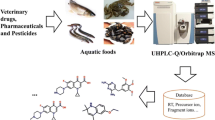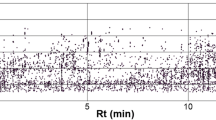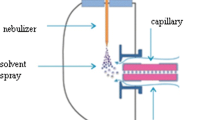Abstract
This paper reports a novel approach for the detection, confirmation, and quantification of 15 selected pyrethroid pesticides, including pyrethins, and two metabolites of dithiocarbamates in foods by ultra-performance liquid chromatography–tandem mass spectrometry (UPLC–MS–MS). The proposed method makes use of a modified QuEChERS (quick, easy, cheap, effective, rugged, and safe) procedure that combines isolation of the pesticides and sample cleanup in a single step. Analysis of pyrethroids and dithiocarbamate metabolites was performed by UPLC–MS–MS operated with electrospray and atmospheric pressure chemical ionization, respectively. Two specific precursor–product ion transitions were acquired per target compound in multiple reaction monitoring (MRM) mode. Such acquisition achieved the minimum number of identification points according to European Commission (EC) document no. SANCO/10684/2009, thus fulfilling the EC point system requirement for identification of contaminants in samples. The method was validated with a variety of food samples. Calibration curves were linear and covered from 1 to 800 μg kg−1 in the sample for all target compounds. Average recoveries, measured at mass fractions of 10 and 100 μg kg−1 for pyrethroids and 5 and 50 μg kg−1 for dithiocarbamate metabolites, were in the range of 70–120% for all target compounds with relative standard deviations below 20%. Method limits of quantification (MLOQ) were 10 μg kg−1 and 5 μg kg−1 for pyrethroids and dithiocarbamate metabolites, respectively. The method has been successfully applied to the analysis of 600 food samples in the course of the first Hong Kong total diet study with pyrethroids and metabolites of dithiocarbamates being the pesticides determined.

UPLC–MS/MS chromatogram for twenty target analytes spiked at the MLOQ level



Similar content being viewed by others
References
Casida JE, Quistad GB (1995) Pyrethrum flowers: Production, Chemistry, Toxicology, and Uses Oxford University Press, Oxford
Pang GF, Fan CL, Chao YZ, Zhao TS (1994) Packed-column gas chromatographic method for the simultaneous determination of 10 pyrethroid insecticide residues in fruits, vegetables, and grains. J AOAC Int 77(3):738–747
Environmental Health Criteria (1999) World Health Organization, Geneva
Chen ZM, Wang YH (1996) Chromatographic methods for the determination of pyrethrin and pyrethroid pesticide residues in crops, foods and environmental samples. J Chromatogr A 754(1–2):367–395
Gelsomino A, Petrovičová B, Tiburtini S, Magnani E, Felici M (1997) Multiresidue analysis of pesticides in fruits and vegetables by gel permeation chromatography followed by gas chromatography with electron-capture and mass spectrometric detection. J Chromatogr A 782:105–122
Woudneh MB, Oros DR (2006) Pyrethroids, pyrethrins, and piperonyl butoxide in sediments by high-resolution gas chromatography/high-resolution mass spectrometry. J Chromatogr A 1135(1):71–77
Martínez DB, Vázquez PP, Galera MMn, García MDG (2006) Determination of pyrethroid insecticides in vegetables with liquid chromatography using detection by electrospray mass spectrometry. Chromatographia 63:487–491
Kuang H, Miao H, Hou XL, Zhao YF, Shen JZ, Xu CL, Wu YN (2009) Determination of pyrethroid residues in pork muscle by immunoaffinity cleanup and GC–ECD. Chromatographia 70(5–6):995–999
Vettorazzi G, Almeida WF, Burin GJ, Jaeger RB, Puga FR, Rahde AF, Reyes FG, Schvartsman S (1995) International safety assessment of pesticides: dithiocarbamate pesticides, ETU, and PTU—a review and update. Teratog Carcinog Mutagen 15(6):313–337
Houeto P, Bindoula G, Hoffman JR (1995) Ethylenebisdithiocarbamates and ethylenethiourea: possible human health hazards. Environ Health Perspect 103(6):568–573
Marshall WD (1977) Thermal decomposition of ethylenebisdithiocarbamate fungicides to ethylenethiourea in aqueous media. J Agric Food Chem 25(2):357–361
Watts RR, Storherr RW, Onley JH (1974) Effects of cooking on ethylenebisdithiocarbamate degradation to ethylene thiourea. Bull Environ Contam Toxicol 12(2):224–226
Anastassiades M, Lehotay SJ, Stajnbaher D, Schenck FJ (2003) Fast and easy multiresidue method employing acetonitrile extraction/partitioning and "dispersive solid-phase extraction" for the determination of pesticide residues in produce. J AOAC Int 86(2):412–431
Lehotay SJ, de Kok A, Hiemstra M, Van Bodegraven P (2005) Validation of a fast and easy method for the determination of residues from 229 pesticides in fruits and vegetables using gas and liquid chromatography and mass spectrometric detection. J AOAC Int 88(2):595–614
QuEChERS. www.quechers.com. Assessed 2 Feb 2012
Koesukwiwat U, Lehotay SJ, Mastovska K, Dorweiler KJ, Leepipatpiboon N (2010) Extension of the QuEChERS method for pesticide residues in cereals to flaxseeds, peanuts, and doughs. J Agric Food Chem 58(10):5950–5958
Rawn DF, Judge J, Roscoe V (2010) Application of the QuEChERS method for the analysis of pyrethrins and pyrethroids in fish tissues. Anal Bioanal Chem 397(6):2525–2531
European Commission (2010) Method validation and quality control procedures for pesticide residues analysis in food and feed, Document No. SANCO/10684/2009, Brussels 1 January 2010
Chung SW, Chan BT (2010) Validation and use of a fast sample preparation method and liquid chromatography–tandem mass spectrometry in analysis of ultra-trace levels of 98 organophosphorus pesticide and carbamate residues in a total diet study involving diversified food types. J Chromatogr A 1217(29):4815–4824
Codex Alimentarius Commission Pesticide residues in food and feed, Rome. http://wwwcodexalimentariusnet/pestres/data/indexhtml. Accessed 2 Feb 2012
Author information
Authors and Affiliations
Corresponding author
Rights and permissions
About this article
Cite this article
Chung, S.W.C., Lam, C.H. Development and validation of a method for determination of residues of 15 pyrethroids and two metabolites of dithiocarbamates in foods by ultra-performance liquid chromatography–tandem mass spectrometry. Anal Bioanal Chem 403, 885–896 (2012). https://doi.org/10.1007/s00216-012-5882-1
Received:
Revised:
Accepted:
Published:
Issue Date:
DOI: https://doi.org/10.1007/s00216-012-5882-1




